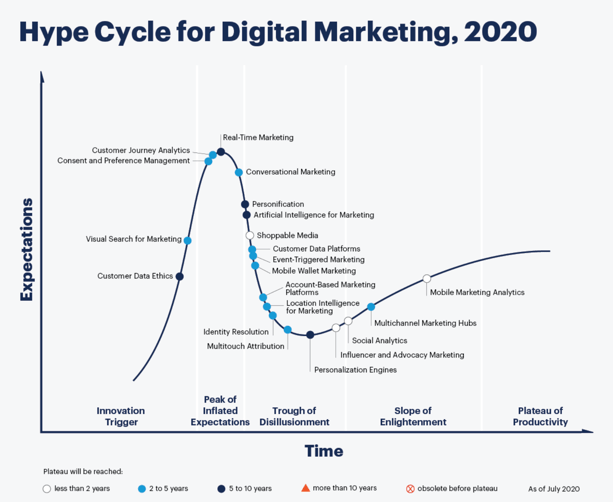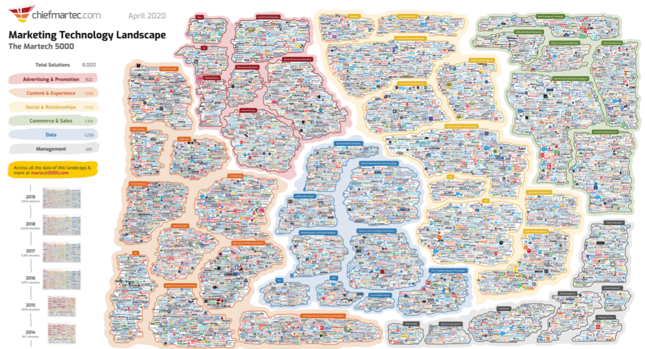Future trends in B2B marketing that we simply cannot ignore
The Covid pandemic demonstrated on a practical level how unexpected variables make it difficult to predict the future. The majority of marketing trend reviews focus on the hottest phenomena, tools and channels of the next 6-12 months, although short-term predictability is more difficult than ever. Major long-term technological developments are, in fact, much more predictable. In this article, we summarize the key phenomena and trends affecting B2B marketing that are already shaping the way companies operate. Slowly but surely.
Gartner's Hype Cycle
The industry-specific Hype Cycle, published annually by Gartner, provides a comprehensive overview of which phenomena and technologies affect our lives in the short, medium and long term. The phenomena follow a certain pattern of adaptation and follow the hype curve of the chart: through initial enthusiasm to the “valley of disappointments,” from which the phenomenon slowly becomes established on a practical level as part of our daily lives.
The latest Digital Marketing Hype Cycle was released last summer, so it serves as a good benchmark for the corresponding report a year ago. Although we lived in the midst of the worst pandemic shock in the summer, its effects did not extend to destabilizing long-term trends that, as expected, continued to evolve on the graph.
 Pictured is Gartner’s Digital Marketing Hype Cycle 2020. This report covers both B2B and B2C phenomena.
Pictured is Gartner’s Digital Marketing Hype Cycle 2020. This report covers both B2B and B2C phenomena.
An interesting example is the Multitouch Attribution, which has been one of the hottest topics in B2B marketing over the past couple of years. In reality, the technology at hand has not yet been able to provide powerful enough and practical tools to implement attribution reporting. Sometimes the inability of organizations to absorb new phenomena effectively enough as part of operational change can also be a challenge, even when tools are already in place.
Key trends in B2B marketing in the short to medium term
We set out to outline the key trends that will shape the field of B2B marketing in the coming years.
The changing roles of sales and marketing
The B2B sales process has been approached linearly through the ages: from awareness to identification and reflection and ultimately to the decision to make a purchase. Marketing and sales teams continue to be most commonly organized in succession rather than functioning partially overlapping. The job of marketing is to build awareness, identify potential customers, and transfer them as leads to the sales team.
According to a study by Gartner (B. Adamson), traditional linear sales process thinking is helplessly outdated. The points of contact in the B2B sales process often take place in a completely unpredictable order, making it impossible to organize them into a linear funnel. Sales and marketing teams need to adapt to this modern purchasing process and question the way departments, teams and functions are organized to best serve potential buyers. In the future, marketing will play a key hybrid role: it will no longer act alone at the beginning of the purchasing path, but will play a key role at every stage of the life cycle, from lead to customer and customer to referrer.
ABM platforms
As the line between marketing and sales blurs, Account Based Marketing (ABM) will play an even more central role in the future. There is nothing new in ABM itself: it is a common strategy for sales and marketing, the key objective of which is to focus resources on identified potential key customers and thereby create greater value for the business. You can read more about ABM in our previously published article.
There has been a lot of talk of ABM in recent years, even to the point of boredom, but only now is the time beginning to be ripe for exploiting strategy beyond the mere ideology. As can be seen from the Hype Cycle presented above, ABM is finally moving from talk to practice and the market is beginning to provide genuinely usable tools to implement strategy on a practical level. Among other things, HubSpot unveiled its new ABM functionality last summer.
Consolidation of Martech
The number of marketing technologies has grown exponentially in recent years: in 2011, Scott Brinker’s Marketing Technology Landscape had only 150 tools, up to more than 8,000 in 2020. The tools have provided marketers with wild opportunities - perhaps even too many. Our operations are fragmented into dozens of different systems and we have an almost limitless amount of data at our disposal. Believe it or not, the number of tools in use is slowly starting to decline. The aim is to centralize and integrate operations into key systems in order to get a more comprehensive overview of our customers and marketing measures.
 Marketing Technology Landscape 2020
Marketing Technology Landscape 2020
HubSpot is an excellent example of a system that aims to evolve into a more versatile customer lifecycle tool, growing horizontally as well as integrating with the most common marketing, sales, and customer service tools. The boundaries between marketing automation systems, CRM platforms, and customer relationship management tools are blurring. In the future, we will be talking about CDP platforms, ie. Customer Data Platforms, which bring together all the data related to the customer's life cycle under one system. This way, all customer-related data is always up-to-date and available to all people working in the customer interface.
Content marketing
Content marketing doesn’t seem to be disappearing from the B2B marketers toolkit in the near future. According to the Content Marketing Institute, the importance of content marketing will continue to grow in the future. Content marketing has contributed to experiencing inflation: too much and too bad content. As tools evolved and made it possible to automate all communications, we became greedy. Successful ones are those who dare to choose a narrower niche and target communication to a well-defined target audience instead of serving hand-warm and soulless content to everyone.
Millennials have become an important part of the B2B buyer group and they consume content in very different ways than their predecessors. Millennials have been studied to be less price sensitive and choose the most appropriate operator based on who resonates best with their own values. The task of the buyer is not easy: there is a huge amount of data available that makes the comparison tedious. Instead of technical product descriptions, buyers want well-crafted and pre-chewed materials that best support comparison and decision-making.
Customer experience development
The biggest barrier for marketers to better personalization is data - not its lack, but inefficient utilization. We are able to collect data from even the smallest nanopoints but still are not able to utilize them in our marketing. More is not equal to better. Organizations that will focus resources on building a better customer experience with data, will stand out from the crowd.
Millennials as buyers are ruthless in this regard: if the customer experience doesn’t live up to their expectations, they will turn around. Usually you have just one chance you can’t afford to miss. The abovementioned CDP platforms will play a significant role in creating customer understanding and a better service experience.
AI and machine learning
Artificial intelligence will inevitably affect each of us. According to an Adobe study, as many as 41 % of the world’s leading companies already utilize artificial intelligence and machine learning. The biggest benefit of machine learning and artificial intelligence is freeing up automated resources for the tasks that really benefit them the most. We will focus more and more of our time on strategy work, developing innovations, building collaboration, deeper research and understanding of customers on an emotional level. Machine learning is possible when there is a large enough amount of data to interpret the overall picture. Before we can take full advantage of the potential of advanced technology, we need to ensure that data related to all of customer’s points of contact can be found under a single system.
On the other hand, artificial intelligence and machine learning have already gone unnoticed into our everyday lives.
We are already leveraging this technology in areas such as analytics, optimization, testing, personalization, email marketing, automated purchasing, and video recognition, for example. By 2025, there will already be 61 % more data in the world than today. Without machine learning and artificial intelligence, we will soon be unable to process all the data in use.
Meaningful metrics
The growing amount of data will further blur marketers’ understanding of which metrics are really key to measuring the overall effectiveness, performance and impact of an organization. It doesn’t help that teams and departments work in their own systems, giving everyone their own “truth” about what the company’s overall situation is. Marketing measures its own success from marketing data, sales measures its own success from CRM, and the service team measures its customer service systems. When these teams and data do not intersect, it is impossible for an organization to build a clear overall picture of the direction and current state of the business.
Revenue Operations (RevOps) will change traditional organizational structures by breaking the silos between marketing, sales and customer teams. RevOps' mission is to align an organization's goals, data and processes so that they best support the organization's most productive processes. On a team-by-team basis, metering will gradually move to measuring key business objectives and performance. As marketing and sales become more integrated into one business unit, it is clear, that the old indicators will no longer serve the development of operations.
Sources
- Gartner 2020 Hype Cycle for Digital marketing :
- Gartner (B. Adamson) CSO Update: The new B2B buying journey and its implication for sales
- Chief MarTech: (S. Brinker)
- Content Marketing Institute: B2B research
- Dnb: B2B Enters the experience Era report
- Adobe-blogi M. Cardona
- Adobe: Digital trends report
- Seagate whitepaper: Data-age
Want to learn more? Download the free guide! A hands-on guide to building sales and marketing collaboration models using the HubSpot system. Collect hands-on tips, exercises, and tool tips for teams to use.
/kaksio-labs-logo-white.png?width=150&height=69&name=kaksio-labs-logo-white.png)
